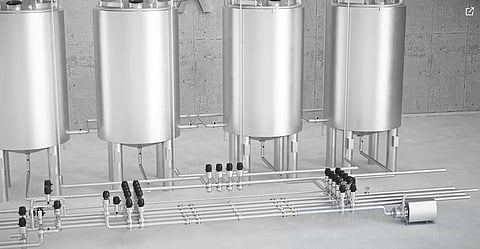
- Home
- EventsEvents
- Product Launches
- CategoriesCategories
- Advertise
- Opinion

Up to four feedbacks can be applied to ensure exact control and documentation of the valve status at all times.
Photo - GEA
GEA is launching a key element for process safety in the food, beverage, dairy and pharmaceutical industries: the mixproof double-seat valve Type MX from the GEA VARIVENT family. Safety is crucial for the future viability of production plants, product integrity and the ever-increasing hygiene requirements are regarded as potent drivers of innovation. With advanced process components such as the new “MX” valve generation, GEA supports companies that aspire to play a pioneering role in product safety.
Anticipating tomorrow’s safety standards
Manufacturers of food and other hygienically processed products are already striving to attain high quality standards. They face the challenge of maintaining reproducible processes so that their products have the appearance, taste, and consistency that consumers expect. In the future, production conditions will be even more complex. Alternative resources and new processes, for example in the plant-based or New Food sector, call for even more comprehensive safety concepts. “For these foods of the future, you also need factories of the future. Our new generation of valves is a key component in the production structure. By anticipating tomorrow’s safety standards, we are consciously relieving the burden on customers,” explains Bastian Tolle, vice president Product Management & Engineering, Valves & Pumps, GEA.
Thanks to specially shaped balancers in both pipelines, the valve remains stable in the closed position even in the event of water hammer and, on the other hand, retains its full ability to act even in the case of thermal expansion of the medium.
Photo - GEA
Preventing mixing when seals fail
GEA has designed the VARIVENT MX with elements that keep products from mixing with the cleaning liquid, even under exceptional loads. The cavity chamber is fitted with a vacuum self-drainage system and balancers on both valve disks. For maximum physical safety, GEA makes use of the Venturi effect: This is created by the special shape of the flow channels, which causes a vacuum on the opposite seal during lifting, preventing pressure increases. As a result, no cleaning liquid can enter the opposite pipe carrying the product while a valve seat is being lifted or cleaned, even if a seal is defective.
Double balancers prevent overpressure
When new systems are set up and adjusted in a short time, there is a higher risk of overpressure during operation. The valve disks must stay in place when these water hammers occur, and the valve must remain closed. For this purpose, GEA has equipped the valve disks in both pipelines with balancers – pressure compensators. This makes the closed valve resistant to water hammers up to 50 bar in the upper and lower pipelines. The new MX valve type also has an integrated balancer cleaning device. It ensures that the balancer is completely flushed from the outside during seat lifting at the same time as cleaning-in-place is realized. All surfaces in contact with the product can be cleaned without any additional components protecting the product from contamination.
Entire valve unit ensures process control
To ensure maximum control, GEA’s hygiene concept includes the entire valve unit, including the control top. By means of the GEA T.VIS control top, GEA integrates the double-seat valves into the automation concepts of the units. In this way, the operator can monitor the exact switching position of the valve at any time and be fully aware of the valve functions. This makes the processes even more reliable. “So far, not all industries use this valve unit. Nevertheless, the digital monitoring and control functions are a basic prerequisite for Industry 4.0-capable production lines,” valve expert Tolle points out. GEA wants to encourage manufacturers to take this step because control tops have immense potential in the light of predictive maintenance and process sustainability. They would also help plant operators boost the traceability and verifiability of the hygienic process chain.
